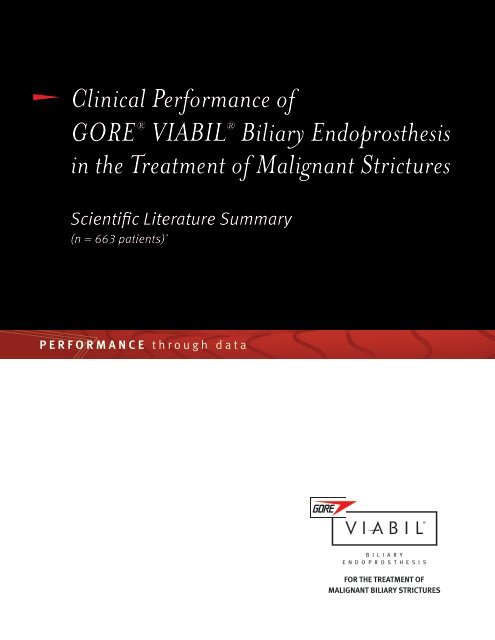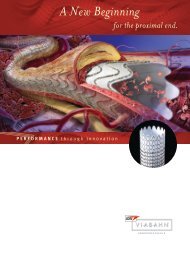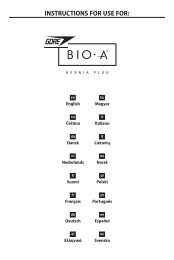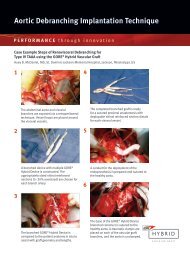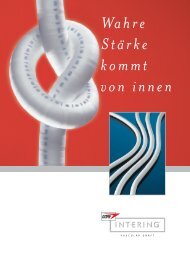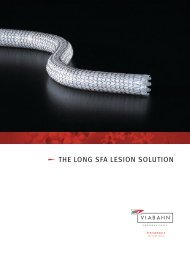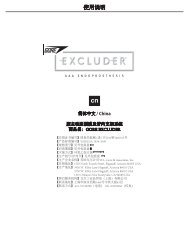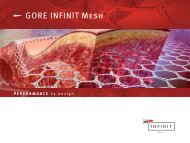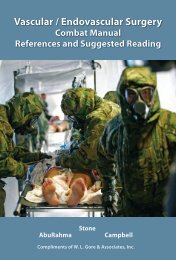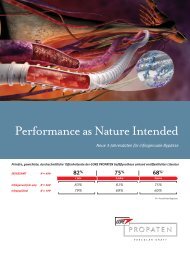Create successful ePaper yourself
Turn your PDF publications into a flip-book with our unique Google optimized e-Paper software.
<strong>Clinical</strong> Performance of<br />
GORE ® VIABIL ® Biliary Endoprosthesis<br />
in the Treatment of Malignant Strictures<br />
Scientific Literature Summary<br />
(n = 663 patients) *<br />
PER F ORM ANC E through data
GORE ® VIABIL ® Biliary Endoprosthesis –<br />
Advancing Biliary Therapy<br />
The First Fully Covered SEMS with Anti-Migration Anchoring Fin Technology.<br />
Demonstrated Anti-Migration<br />
– Atraumatic, defeatable anchoring fin technology **<br />
Proven Long-Term Patency<br />
– Impermeable ePTFE/FEP covering **<br />
• Prevents tumor ingrowth<br />
• Resists initial bacterial attachment minimizing the risk of bio-sludge occlusion<br />
– High radial strength resists tumor progression<br />
Accurate Easy Delivery<br />
– Non shortening stent design **<br />
– Exclusive pull line deployment ** (endoscopic)<br />
– Radiopaque markers enable precise placement<br />
Exceptional Conformability with Uncompromised Radial Strength<br />
– Nitinol wire exoskeleton with an ultrathin ePTFE/FEP covering **<br />
– Continuous wire stent design naturally follows tortuous anatomy<br />
Minimal Risk of Branch Duct Exclusion<br />
– Optional fenestrations help maintain transmural drainage<br />
– Additional radiopaque marker ensures proper positioning<br />
In the last ten years, more than 700,000 <strong>Gore</strong> ePTFE stent grafts † have been<br />
implanted worldwide.<br />
**Proprietary <strong>Gore</strong> technology<br />
Indications for Use:<br />
USA: THE GORE ® VIABIL ® Biliary Endoprosthesis is indicated for the treatment of malignant biliary strictures.<br />
Europe and Canada: The Removable GORE ® VIABIL ® Biliary Endoprosthesis is indicated for the treatment of benign<br />
and malignant biliary strictures and can be removed from such strictures for up to one year post implant.<br />
Refer to Instructions For Use for a complete description of all warnings, precautions, and contraindications.<br />
Products listed may not be available in all markets. For product availability in regions not listed, please contact<br />
W. L. <strong>Gore</strong> & Associates, Inc.<br />
*<strong>Data</strong> based on an analysis of current literature: several Medline and abstract searches were performed to identify publications pertaining to GORE ® VIABIL ® Biliary<br />
Endoprosthesis. Search criteria included (1) articles published January 1999 through March 2011, (2) key words used were GORE ® VIABIL ® Biliary Endoprosthesis,<br />
covered biliary stent, PTFE, malignant, (3) articles in English language, (4) N equal or greater than 10 patients, (5) clinical publications, abstracts, (6) case reports<br />
were excluded, (7) current endoscopic delivery system, (8) studies which included multiple biliary stents were identified and percent use with GORE ® VIABIL ® Biliary<br />
Endoprosthesis were reported. Articles that did not meet the above criteria were not included in this summary.<br />
†<br />
GORE ® VIABAHN ® , VIATORR ® , VIABIL ® , EXCLUDER ® , TAG ® Products
Proven Performance Through <strong>Data</strong><br />
<strong>Clinical</strong> Performance of GORE ® VIABIL ® Biliary Endoprosthesis for the Treatment of Malignant Strictures<br />
VIABIL ® Device<br />
Patients<br />
Technical<br />
Success<br />
Lifetime<br />
Paliation<br />
Primary<br />
Patency (days)<br />
Percent Primary Patency 1<br />
3 Months 6 Months 12 Months<br />
n=663<br />
Range<br />
97-100%<br />
87.4%<br />
(256/293)<br />
Range<br />
117 - 234<br />
96% 85% 72%<br />
Dysfunctions (e.g.<br />
tumor overgrowth)<br />
Time to Reintervention<br />
(days)<br />
Migration Cholecystitis Pancreatitis<br />
9.7% (40/412) Mean Range 84 - 295 0.3% 3.8% 2.3%<br />
As Compared To:<br />
Migration Cholecystitis Pancreatitis<br />
Covered Stents (partial & fully covered) 3 - 13% 2,3 2%-12% 3,4 5.1% - 8.7% 5<br />
1<br />
Percent primary patency calculated using weighted average from available Kaplan-Meier survival and primary patency rates for 3, 6, and 12 months. References<br />
without Kaplan-Meier data are not included in patency summary results.<br />
2<br />
Schoder M, Rossi P, Uflacker R, et al. Malignant biliary obstruction: treatment with ePTFE-FEP-covered endoprostheses initial technical and clinical experiences in a<br />
multicenter trial. Radiology 2002;225(1):35-42.<br />
3<br />
Kahaleh M, Tokar J, Conaway MR, et al. Efficacy and complications of covered Wallstents in malignant distal biliary obstruction. Gastrointestinal Endoscopy<br />
2005;61(4):528-533.<br />
4<br />
Kullman E, Frozanpor F, Söderlund C, et al. Covered versus uncovered self-expandable nitinol stents in the palliative treatment of malignant distal biliary obstruction:<br />
results from a randomized, multicenter study. Gastrointestinal Endoscopy 2010;72(5):915-923.<br />
5<br />
Coté GA, Kumar N, Ansstas M, Edmundowicz SA, Jonnalagadda S, Mullady DK, Azar RR. Risk of post-ERCP pancreatitis with placement of self-expandable metallic<br />
stents. Gastrointestinal Endoscopy 2010;72(4):748-754
Percutaneous Palliation of Pancreatic Head Cancer:<br />
Randomized Comparison of ePTFE/FEP-Covered Versus<br />
Uncovered Nitinol Biliary Stents<br />
Krokidis M, Fanelli F, Orgera G, Tsetis D, Mouzas M, Bezzi M, Kouroumalis E, Pasariello R,<br />
Hatzidakis A, 2011 1<br />
Device Patients<br />
Technical<br />
Success<br />
Lifetime<br />
Paliation<br />
Primary<br />
Patency (days)<br />
Percent Primary Patency<br />
3 Months 6 Months 12 Months<br />
VIABIL ® Device n=40 100% 90% (36/40) Mean 234 97.3% 92.2% 87.6%<br />
LUMINEXX n = 40 100% 70% (28/40) Mean 166 77.5% 69.8% 69.8%<br />
Dysfunctions (e.g.<br />
tumor overgrowth)<br />
Time to Reintervention<br />
(days)<br />
Migration Cholecystitis Pancreatitis<br />
10% (4/40)* Mean 126.5 0/40 0/40 0/40<br />
30% (12/40) Mean 82.9 0/40 0/40 0/40<br />
*p < 0.05<br />
Study Details<br />
• Design: multicenter, prospective, randomized<br />
• Purpose: compare clinical effectiveness of covered GORE ® VIABIL ® Biliary Endoprosthesis stents (n = 40) to uncovered<br />
metallic LUMINEXX Device stents (n = 40)<br />
• Etiology: 80 pancreatic adenocarcinoma<br />
• Inclusion: obstructive jaundice caused by unresectable pancreatic head adenocarcinoma, which in turn caused<br />
occlusion of the biliary tree at the lower half of the common bile duct.<br />
• Exclusion: three of six of the following: total serum bilirubin level ≥15 mg/dl, leukocytosis ≥11 x 10 9 /l,<br />
gamma glutamil transferase (yGT) >165 IU/l, prothrombin ratio ≥1.4, C-reactive protein (CRP) ≥5 mg/dl,<br />
and serum carbohydrate antigen 19-9 (CA 19-9)level ≥10.000 IU/ml.<br />
• Survival / Implant Duration / Follow-up:<br />
– GORE ® VIABIL ® Biliary Endoprosthesis: ~8.1months (mo): median 247days (d)<br />
– LUMINEXX : ~6.7mo: median 203d<br />
• Complications:<br />
– GORE ® VIABIL ® Biliary Endoprosthesis: 12.5% (5/40) - 3 peritoneal irritation, 2 self limited biliary hemorrhage<br />
– LUMINEXX : 10% (4/40) - 2 peritoneal irritation, 2 self limited biliary hemorrhage<br />
Conclusions<br />
“Regarding primary patency and ingrowth rate, ePTFE/FEP-covered stents [GORE ® VIABIL ® Biliary Endoprosthesis]<br />
have shown to be significantly superior to bare nitinol stents for the palliation of malignant jaundice caused by<br />
inoperable pancreatic head cancer and pose comparable cost and complications.”<br />
“Use of a covered stent does not significantly influence overall survival rate; nevertheless, the covered endoprosthesis<br />
seems to offer result in fewer reinterventions and better quality of patient life.”
Fully Covered Self Expandable Metal Stents (CSEMS) for<br />
Malignant Distal Biliary Strictures: Mid-term Evaluation<br />
Bakhru M, Ho HC, Gohil V, Wang AY, Ellen K, Sauer BG, Shami VM, Kahaleh M., 2011 2<br />
VIABIL ® Device<br />
Patients<br />
Technical<br />
Success<br />
Lifetime<br />
Paliation<br />
Primary<br />
Patency (days)<br />
Percent Primary Patency<br />
3 Months 6 Months 12 Months<br />
n = 70 NA 71% (29/34)<br />
Mean 163<br />
(15-1093)<br />
NA NA NA<br />
Dysfunctions (e.g.<br />
tumor overgrowth)<br />
Time to Reintervention<br />
(days)<br />
Migration Cholecystitis Pancreatitis<br />
4.3% (3/70) Mean 155 (69-295) 1.4% (1/70) 4.2% (3/70) 11.4% (8/70)<br />
Study Details<br />
• Design: prospective data collection<br />
• Purpose: evaluate safety and patency of fully covered metal stent (CSEMS) with anchoring fins for malignant<br />
biliary strictures<br />
• Etiology: 53 pancreatic malignancy, 7 ampullary cancers, 4 metastatic diseases, 3 gallbladder cancers,<br />
2 cholangiocarcinoma, 1 duodenal carcinoma<br />
• Inclusion: management of malignant distal biliary strictures between October 2006 and September 2008<br />
• Exclusion: NA<br />
• Survival / Implant Duration / Follow-up: ~5.9mo: mean 180d (15d-1092d)<br />
• Complications: 41.4% (29/70) - 4 wire perforation, 8 pancreatitis, 4 proximal deployment requiring reposition,<br />
5 pain, 3 cholecystitis, 2 cholangitis, 1 proximal migration, 1 post-shincterotomy bleeding, 1 sepsis<br />
Conclusions<br />
“CSEMS appear to provide acceptable short-term patency rates; however, their limited long-term patency and<br />
high complication rate may limit their widespread use. Further long-term prospective data is required to confirm<br />
this observation.”
Percutaneous Treatment of Malignant Jaundice Due to<br />
Extrahepatic Cholangiocarcinoma: Covered Viabil [GORE ® VIABIL ®<br />
Biliary Endoprosthesis] Stent Versus Uncovered Wallstents<br />
Krokidis M, Fanelli F, Orgera G, Bezzi M, Passariello R, Hatzidakis A, 2010 3<br />
Device Patients<br />
Technical<br />
Success<br />
Lifetime<br />
Paliation<br />
Primary<br />
Patency (days)<br />
Percent Primary Patency<br />
3 Months 6 Months 12 Months<br />
VIABIL ® Device n = 30 100% 87% (26/30) Mean 227.3 NA NA NA<br />
WALLSTENT ® n = 30 100% 70% (21/30) Mean 166.0 NA NA NA<br />
Dysfunctions (e.g.<br />
tumor overgrowth)<br />
Time to Reintervention<br />
(days)<br />
Migration Cholecystitis Pancreatitis<br />
13.3% (4/30)* Mean 179.5* 0/30 0/30 0/30<br />
30% (9/30) Mean 133.1 0/30 0/30 0/30<br />
*p < 0.05<br />
Study Details<br />
• Design: multicenter, prospective, randomized<br />
• Purpose: compare the clinical results of GORE ® VIABIL ® Biliary Endoprosthesis (n = 30) stent-grafts versus<br />
WALLSTENT ® Devices (n = 30)<br />
• Etiology: 80 unresectable extrahepatic cholangiocarcinoma<br />
• Inclusion: Bismuth type I unresectable extrahepatic cholangiocarcinoma, with a total serum bilirubin level 3 on the Eastern Cooperative Oncology Group scale<br />
• Exclusion: intrahepatic and hepatic bifurcation (Klatskin) tumors, presence of hepatic metastasis, patient age<br />
[80 years, previous surgical or radiotherapeutical palliative treatment, and very poor patient general condition]<br />
• Survival / Implant Duration / Follow-up:<br />
– GORE ® VIABIL ® Biliary Endoprosthesis: ~8.0mo: median 243.5d<br />
– WALLSTENT ® : ~5.9mo: median 180.5<br />
• Complications:<br />
– GORE ® VIABIL ® Biliary Endoprosthesis: 10% (3/30) - 2 peritoneal irritation, 1 biloma formation<br />
– WALLSTENT ® : 13.3% (4/30) - 3 peritoneal irritation, 1 self limited biliary hemorrhage<br />
Conclusions<br />
“In conclusion, Viabil [GORE ® VIABIL ® Biliary Endoprosthesis] stents have been shown to be safe for palliation of<br />
malignant jaundice caused by extrahepatic cholangiocarcinoma. They also seem to be effective in preventing tumor<br />
ingrowth and may therefore reduce the rate of stent occlusion and increase patients’ quality of life.”<br />
“The results of this study suggest that Viabil [GORE ® VIABIL ® Biliary Endoprosthesis] stents may be superior to<br />
conventional uncovered WALLSTENT ® Device in the management of malignant biliary obstruction due to Bismuth type<br />
I cholangio-carcinoma, with similar costs and complication rates, and, therefore, should be considered as the first<br />
option in the selection of an endoprosthesis, especially for inoperable patients in relatively good general condition.”
Use of ePTFE Covered Stents for Malignant Biliary Strictures<br />
Syed LH, Hong K, Syed LH, 2009 4<br />
VIABIL ® Device<br />
Patients<br />
Technical<br />
Success<br />
Lifetime<br />
Paliation<br />
Primary<br />
Patency (days)<br />
Percent Primary Patency<br />
3 Months 6 Months 12 Months<br />
n=28 NA 93% (26/28) Mean 126 NA (Overall Primary Patency: 96%)<br />
Dysfunctions (e.g.<br />
tumor overgrowth)<br />
Time to Reintervention<br />
(days)<br />
Migration Cholecystitis Pancreatitis<br />
3.7% (1/27) 259 NA NA NA<br />
Study Details<br />
• Design: retrospective chart review<br />
• Purpose: to demonstrate both patency and need for secondary interventions with the use of ePTFE covered<br />
biliary endostents for malignant biliary strictures<br />
• Etiology: 25 pancreatic adenocarcinoma, 3 other<br />
• Inclusion: placement of covered endostents for malignant biliary strictures as palliation between May 10, 2005<br />
and June 20, 2007<br />
• Exclusion: NA<br />
• Survival / Implant Duration / Follow-up: ~4.1mo: median 126d (11-530)<br />
• Complications: NA<br />
Conclusions<br />
“ePTFE covered biliary endostent for malignant biliary stricture palliation demonstrates a high primary patency<br />
rate (96%) suggesting stent patency outlives patient survival.”<br />
“The low secondary intervention rate (n=1, 3%) suggests the notion that palliation may be achieved satisfactorily<br />
with covered biliary endostents.”
Management of Malignant Biliary Obstruction: Technical and<br />
<strong>Clinical</strong> Results Using an Expanded Polytetrafluoroethylene<br />
Fluorinated Ethylene Propylene (ePTFE/FEP) Covered Metallic<br />
Stent After 6-year Experience<br />
Fanelli F, Orgera G, Bezzi M, Rossi P, Allegritti M, Passariello R, 2008 5<br />
VIABIL ® Device<br />
Patients<br />
Technical<br />
Success<br />
Lifetime<br />
Paliation<br />
Primary<br />
Patency (days)<br />
Percent Primary Patency<br />
3 Months 6 Months 12 Months<br />
n = 80 100% 91% (70/77) Mean 117 95.5% 92.6% 85.7%<br />
Dysfunctions (e.g.<br />
tumor overgrowth)<br />
Time to Reintervention<br />
(days)<br />
Migration Cholecystitis Pancreatitis<br />
9.1% (7/77) Mean 84 0/77 3.9% (3/77) 0/77<br />
Study Details<br />
• Design: prospective data collection<br />
• Purpose: evaluate the efficacy and safety of an expanded polytetrafluoroethylene-fluorinated ethylenepropylene<br />
(ePTFE/FEP)-covered metallic stent in the management of malignant biliary obstruction<br />
• Etiology: 46 pancreatic cancer, 8 cholangiocarcinoma, 2 gallbladder cancer, 24 metastatic lymphadenopathy<br />
• Inclusion: obstruction of the CBD below the hilar confluence due to unresectable malignancy<br />
• Exclusion: previous biliary surgery, previous insertion of metallic stents or uncontrollable coagulopathy (INR >3.0)<br />
• Survival / Implant Duration / Follow-up: mean 6.9mo (1mo: 66/77, 6mo: 31/77, 12mo:16/77)<br />
• Complications: 6.5% (5/77) - 1 perihepatic biloma, 1 peri and intrahepatic blood collection, 3 cholecystitis<br />
(5 days, 4 mo, 4.5mo)<br />
Conclusions<br />
“The percentage of patients undergoing lifetime palliation (91%) and the midterm patency rate suggest that<br />
placement of this ePTFE/FEP-covered stent-graft is safe and highly effective in achieving biliary drainage in<br />
patients with malignant strictures of the common bile duct.”
ePTFE/FEP Covered Versus Uncovered Metallic Stents for<br />
Malignant Biliary Disease Palliation. Results in 200 Patients<br />
Krokidis M, Fanelli F, Hatzidakis A, Orgera G, Bezzi M, Pasariello R, Gourtsoyiannis N, 2008 6<br />
Device Patients<br />
Technical<br />
Success<br />
Lifetime<br />
Paliation<br />
Primary<br />
Patency (days)<br />
Percent Primary Patency<br />
3 Months 6 Months 12 Months<br />
VIABIL ® Device n=100 98.7% NA NA NA 83.3% 67.6%<br />
WALLSTENT ® n = 100 97.5% NA NA NA 72.3% 50.0%<br />
Dysfunctions (e.g.<br />
tumor overgrowth)<br />
Time to Reintervention<br />
(days)<br />
Migration Cholecystitis Pancreatitis<br />
NA NA NA NA NA<br />
NA NA NA NA NA<br />
Study Details<br />
• Design: unknown<br />
• Purpose: to study the clinical effectiveness, patency and complication rates of ePTFE/FEP covered-metallic<br />
stents (n = 100) compared with uncovered WALLSTENT ® Devices (n = 100), in the palliative treatment of<br />
malignant biliary disease<br />
• Etiology: 98 pancreatic cancer, 51 cholangiocarcinoma, 19 gastric cancer, 17 lymph node enlargement,<br />
9 papillary cancer, 6 gallbladder cancer<br />
• Inclusion: unknown<br />
• Exclusion: unknown<br />
• Survival / Implant Duration / Follow-up:<br />
– GORE ® VIABIL ® Biliary Endoprosthesis: ~4.8mo: mean 147.3d<br />
– WALLSTENT ® : ~4.7mo: mean 142.8d<br />
• Complications:<br />
– GORE ® VIABIL ® Biliary Endoprosthesis: 5% (5/100) – unknown<br />
– WALLSTENT ® : 8% (8/100) – unknown<br />
Conclusions<br />
“Covered-Viabil [GORE ® VIABIL ® Biliary Endoprosthesis] stents are safe and effective for palliative treatment of<br />
malignant biliary disease and seem to offer a better 6 and 12-month patency rate compared with uncovered<br />
WALLSTENT ® Device.”
e-PTFE Covered Metallic Stents for Palliation of Malignant<br />
Biliary Strictures: <strong>Clinical</strong> Results in 140 Patients<br />
Orgera G, Fanelli F, Hatzidakis A, Krokidis M, Conchiglia A, Passariello R, Gourtsoyiannis N, 2007 7<br />
VIABIL ® Device<br />
Patients<br />
Technical<br />
Success<br />
Lifetime<br />
Paliation<br />
Primary<br />
Patency (days)<br />
Percent Primary Patency<br />
3 Months 6 Months 12 Months<br />
n = 140 100% NA NA 91% 79% 78%<br />
Dysfunctions (e.g.<br />
tumor overgrowth)<br />
Time to Reintervention<br />
(days)<br />
Migration Cholecystitis Pancreatitis<br />
NA NA NA 4.3% (6/140) NA<br />
Study Details<br />
• Design: multicenter, retrospective analysis<br />
• Purpose: to evaluate the efficacy of e-PTFE covered stent (GORE ® VIABIL ® Biliary Endoprosthesis) in the treatment<br />
of malignant biliary strictures<br />
• Etiology: 91 pancreatic cancer, 14 cholangiocarcinoma, 8 gallbladder cancer, 27 metastatic lymphadenopathy<br />
• Inclusion: patients with malignant common bile duct (CBD) strictures treated at University-Hospital of Rome (n=95)<br />
and of Heraklion (n=45) with GORE ® VIABIL ® Biliary Endoprosthesis<br />
• Exclusion: unknown<br />
• Survival / Implant Duration / Follow-up: unknown<br />
• Complications: 8.5% (12/140) – unknown<br />
Conclusions<br />
“e-PTFE stent-graft seems to be an effective tool in malignant strictures of the CBD.”
ePTFE/FEP-Covered Metallic Stents for Palliation of Malignant<br />
Biliary Disease: Can Tumor Ingrowth Be Prevented?<br />
Hatzidakis A, Krokidis M, Kalbakis K, Romanos J, Petrakis I, Gourtsoyiannis N, 2007 8<br />
VIABIL ® Device<br />
Patients<br />
Technical<br />
Success<br />
Lifetime<br />
Paliation<br />
Primary<br />
Patency (days)<br />
Percent Primary Patency<br />
3 Months 6 Months 12 Months<br />
n = 36 97% 71% (25/35) NA 100% 55.5% 25%<br />
Dysfunctions (e.g.<br />
tumor overgrowth)<br />
Time to Reintervention<br />
(days)<br />
Migration Cholecystitis Pancreatitis<br />
17% (6/35) Mean 148.1 0/35 0/35 0/35<br />
Study Details<br />
• Design: retrospective clinical investigation<br />
• Purpose: to determine the application and clinical effectiveness of ePTFE/FEP-covered metallic stents for palliation<br />
of malignant biliary disease, and to evaluate the efficiency of stent coverage in preventing tumor ingrowth<br />
• Etiology: 17 pancreatic cancer, 13 cholangiocarcinoma, 2 gastric cancer, 2 gallbladder cancer, 2 lymph node<br />
enlargement due to metastasis<br />
• Inclusion: presence of obstructive jaundice from inoperable malignant biliary disease that could not be treated<br />
endoscopically<br />
• Exclusion: significant ascites, a previously inserted biliary stent, previous biliary surgery or radiotherapy, an INR<br />
value >1.5, and a platelet count
Biliary Drainage in Malignant Strictures Using a PTFE Covered Stent<br />
(Viabil [GORE ® VIABIL ® Biliary Endoprosthesis]): Personal Results<br />
Marzio A, Gasparini D, Zanetti S, Piccoli G, Vit A, Sponza M, Pelizzo F, 2005 9<br />
VIABIL ® Device<br />
Patients<br />
Technical<br />
Success<br />
Lifetime<br />
Paliation<br />
Primary<br />
Patency (days)<br />
Percent Primary Patency<br />
3 Months 6 Months 12 Months<br />
n = 26 100% 96% (22/23) NA 100% 100% 85%<br />
Dysfunctions (e.g.<br />
tumor overgrowth)<br />
Time to Reintervention<br />
(days)<br />
Migration Cholecystitis Pancreatitis<br />
4% (1/23) NA 0/23 0/23 0/23<br />
Study Details<br />
• Design: unknown<br />
• Purpose: to determine the technical efficacy and safety of a covered metallic stent in the management of malignant<br />
biliary obstruction and to evaluate its clinical efficacy by estimating stent patency and patient survival rates<br />
• Etiology: 26 malignant CBD strictures<br />
• Inclusion: patients with a common bile duct stricture caused by malignant disease<br />
• Exclusion: unknown<br />
• Survival / Implant Duration / Follow-up: mean 3 mo (5d-19mo)<br />
• Complications: 0% (0/26)<br />
Conclusions<br />
“Our results suggest that placement of this ePTFE covered stent is feasible and effective in achieving biliary<br />
drainage. The percentage of patients undergoing lifetime palliation and the midterm patency is good in our data.”
ePTFE-Covered Stents in the Palliative Treatment of<br />
Malignant Biliary Obstructions<br />
Irurzun J, Gil S, de Espaòa F, de la Iglesia P, Verdú J, 2004 10<br />
VIABIL ® Device<br />
Patients<br />
Technical<br />
Success<br />
Lifetime<br />
Paliation<br />
Primary<br />
Patency (days)<br />
Percent Primary Patency<br />
3 Months 6 Months 12 Months<br />
n = 45 100% NA NA 100% 98% 91%<br />
Dysfunctions (e.g.<br />
tumor overgrowth)<br />
Time to Reintervention<br />
(days)<br />
Migration Cholecystitis Pancreatitis<br />
8.9% (4/45) NA 0/45 4.4% (2/45) 0/45<br />
Study Details<br />
• Design: unknown<br />
• Purpose: to determine technical and clinical safety and efficiency of expanded polytetrafluoroethylene(ePTFE)-<br />
covered stents in the management of malignant biliary obstructions<br />
• Etiology: 45 malignant bile duct strictures<br />
• Inclusion: patients with malignant bile duct stricture<br />
• Exclusion: unknown<br />
• Survival / Implant Duration / Follow-up: mean 5.6 mo (10d-13mo)<br />
• Complications: 8.9% (4/45) - 1 sepsis/death<br />
Conclusions<br />
“ePTFE-covered stent implantation is feasible and effective in achieving biliary drainage. The percentage of<br />
patients undergoing lifetime palliation and medium-term patencies are promising. The incidence of cholecystitis<br />
should, however, be considered.”
Malignant Biliary Obstruction: Treatment with ePTFE-FEP-Covered<br />
Endoprosthesis- Initial Technical and <strong>Clinical</strong> Experiences in a<br />
Multicenter Trial<br />
Schoder M, Rossi P, Uflacker R, Bezzi M, Stadler A, Funovics MA, Cejna M, Lammer J, 2002 11<br />
VIABIL ® Device<br />
Patients<br />
Technical<br />
Success<br />
Lifetime<br />
Paliation<br />
Primary<br />
Patency (days)<br />
Percent Primary Patency<br />
3 Months 6 Months 12 Months<br />
n = 42 100% NA Mean 138 90% 76% 76%<br />
Dysfunctions (e.g.<br />
tumor overgrowth)<br />
Time to Reintervention<br />
(days)<br />
Migration Cholecystitis Pancreatitis<br />
14.6% (6/41) Mean 106 (36-162) 0/41 7.3% (3/41) 2.4% (1/41)<br />
Study Details<br />
• Design: multicenter, prospective, nonrandomized<br />
• Purpose: to determine and present the initial technical and clinical results of using an expanded polytetrafluoroethylene–<br />
fluorinated ethylene propylene (ePTFE-FEP)–covered biliary endoprosthesis to treat malignant biliary obstruction<br />
• Etiology: 26 pancreatic cancer, 3 cholangiocellular cancer, 1 gallbladder cancer, 1 duodenum cancer, 10 enlarged<br />
lymph nodes due to metastasis, 1 lymphoma<br />
• Inclusion: malignant obstruction of the common bile or hepatic duct, including the hepatic duct confluence, by a<br />
nonresectable tumor, patients who were aged 21 years or older<br />
• Exclusion: history of previous biliary surgery, multiple strictures that required treatment, presence of a nonremovable<br />
metallic biliary stent, diagnosis of active infection of the biliary system, chronic liver disease, uncontrolled coagulation,<br />
severe allergy to contrast material, and/or poor clinical condition with an estimated life expectancy of less than three months<br />
• Survival / Implant Duration / Follow-up: ~5.7mo: mean 173d +/-22d<br />
• Complications: 14.6% (6/41) - 1 perihepatic bile leak, 1 peri and intrahepatic hematoma, 1 pancreatitis, 3 cholecystitis<br />
Conclusions<br />
“In conclusion, the placement of ePTFE-FEP–covered biliary endoprostheses for treatment of malignant biliary<br />
obstructions can be considered safe and effective and the anchoring mechanisms prevent stent migration.”
New ePTFE/FEP-Covered Stent in the Palliative Treatment of<br />
Malignant Biliary Obstruction<br />
Bezzi M, Zolovkins A, Cantisani V, Salvatori FM, Rossi M, Fanelli F, Rossi P, 2002 12<br />
VIABIL ® Device<br />
Patients<br />
Technical<br />
Success<br />
Lifetime<br />
Paliation<br />
Primary<br />
Patency (days)<br />
Percent Primary Patency<br />
3 Months 6 Months 12 Months<br />
n = 26 100% 84% (22/26) NA 91% 77% 77%<br />
Dysfunctions (e.g.<br />
tumor overgrowth)<br />
Time to Reintervention<br />
(days)<br />
Migration Cholecystitis Pancreatitis<br />
16.7% (4/24) Mean 100.4 0/24 12.5% (3/24) 0/24<br />
Study Details<br />
• Design: prospective, nonrandomized<br />
• Purpose: to determine the technical efficacy and safety of an expanded polytetrafluoroethylene and fluorinated<br />
ethylene propylene (ePTFE/FEP)–covered metallic stent in the management of malignant biliary obstruction<br />
and to evaluate its clinical efficacy by estimating stent patency and patient survival rates<br />
• Etiology: 18 pancreatic cancer, 2 cholangiocarcinoma, 1 gallbladder cancer, 5 metastatic lymphadenopathy within<br />
the hepatoduodenal ligament<br />
• Inclusion: presence of malignant obstruction of the CBD below the hilar confluence caused by unresectable<br />
malignant disease for which palliative treatment was indicated<br />
• Exclusion: previous biliary surgery, previous insertion of other metallic endoprostheses, and uncontrollable<br />
coagulopathy (international normalized ratio >3.0)<br />
• Survival / Implant Duration / Follow-up: ~5.4mo (5d - 12.5mo)<br />
• Complications: 16.7% (4/24) - 1 perihepatic biloma, 1 intrapepatic blood collection, 3 cholecystitis (10 days,<br />
4 mo, 4.5mo)<br />
Conclusions<br />
“Preliminary results suggest that placement of this ePTFE/FEP–covered stent is feasible and effective in achieving<br />
biliary drainage. The percentage of patients undergoing lifetime palliation and the midterm patency are promising.<br />
However, the incidence of acute cholecystitis is high. Treatment of a larger group of patients is mandatory to validate<br />
these long-term results.”
References<br />
1. Krokidis M, Fanelli F, Orgera G, et al. Percutaneous palliation of pancreatic head cancer: randomized comparison of ePTFE/FEP-covered<br />
versus uncovered nitinol biliary stents. Cardiovascular & Interventional Radiology. In press.<br />
2. Bakhru M, Ho HC, Gohil V, et al. Fully covered self expandable metal stents (CSEMS) in malignant distal biliary strictures: mid-term<br />
evaluation. Journal of Gastroenterology & Hepatology. In press.<br />
3. Krokidis M, Fanelli F, Orgera G, Bezzi M, Passariello R, Hatzidakis A. Percutaneous treatment of malignant jaundice due to extrahepatic<br />
cholangiocarcinoma: covered Viabil [GORE ® VIABIL ® Biliary Endoprosthesis] stent versus uncovered Wallstents. Cardiovascular<br />
& Interventional Radiology 2010;33(1):97-106.<br />
4. Syed LH, Hong K, Syed LH. Use of ePTFE covered stents for malignant biliary strictures. Abstract presented at the 34th Annual Scientific<br />
Meeting of the Society of Interventional Radiology (SIR); March 7-12, 2009; San Diego, CA. Journal of Vascular & Interventional<br />
Radiology 2009;20(2):Supplement 1:S36. Abstract 91.<br />
5. Fanelli F, Orgera G, Bezzi M, Rossi P, Allegritti M, Passariello R. Management of malignant biliary obstruction: Technical and clinical<br />
results using an expanded polytetrafluoroethylene fluorinated ethylene propylene (ePTFE/FEP)-covered metallic stent after 6-year<br />
experience. European Radiology 2008;18(5):911-919.<br />
6. Krokidis M, Fanelli F, Hatzidakis A, Orgera G, Bezzi M, Pasariello R, Gourtsoyiannis N. ePTFE/FEP covered versus uncovered metallic<br />
stents for malignant biliary disease palliation. Results in 200 patients. Abstract presented at 2008 SIR 33rd Annual Scientific Meeting;<br />
March 15-20, 2008; Washington, DC. Journal of Vascular & Interventional Radiology 2008;19(2):Supplement 1:S112-S113. Abstract 304.<br />
7. Orgera G, Fanelli F, Hatzidakis A,et al. e-PTFE covered metallic stents for palliation of malignant biliary strictures: clinical results in 140<br />
patients. Abstract presented at the 2007 Cardiovascular & Interventional Radiological Society of Europe (CIRSE) Meeting; September<br />
8-12, 2007; Athens, Greece. Cardiovascular & Interventional Radiology 2007;30(Supplement 1):253. Abstract 1307.2.<br />
8. Hatzidakis A, Krokidis M, Kalbakis K, Romanos J, Petrakis I, Gourtsoyiannis N. ePTFE/FEP-covered metallic stents for palliation of<br />
malignant biliary disease: can tumor ingrowth be prevented? Cardiovascular & Interventional Radiology 2007;30(5):950-958.<br />
9. Marzio A, Gasparini D, Zanetti S, et al. Biliary drainage in malignant strictures using a PTFE covered stent (Viabil [GORE ® VIABIL ® Biliary<br />
Endoprosthesis]): personal results. Abstract presented at the 16th Annual Meeting & Postgraduate Course. European Society of<br />
Gastrointestinal & Abdominal Radiology (ESGAR); May 28-31, 2005; Florence, Italy.<br />
10. Irurzun J, Gil S, de Espaòa F, de la Iglesia P, Verdú J. ePTFE-covered stents in the palliative treatment of malignant biliary obstructions.<br />
Abstract presented at the 19th Annual Meeting and Postgraduate Course of the Cardiovascular and Interventional Radiological Society<br />
of Europe (CIRSE); September 25-29, 2004; Barcelona, Spain. Page 132. Abstract 19.1.7.<br />
11. Schoder M, Rossi P, Uflacker R, et al. Malignant biliary obstruction: treatment with ePTFE-FEP-covered endoprostheses initial technical<br />
and clinical experiences in a multicenter trial. Radiology 2002;225(1):35-42.<br />
12. Bezzi M, Zolovkins A, Cantisani V, et al. New ePTFE/FEP-covered stent in the palliative treatment of malignant biliary obstruction.<br />
Journal of Vascular & Interventional Radiology 2002;13(6):581-589.<br />
W. L. <strong>Gore</strong> & Associates, Inc.<br />
Flagstaff, AZ 86004<br />
+65.67332882 (Asia Pacific)<br />
00800.6334.4673 (Europe)<br />
800.437.8181 (United States)<br />
928.779.2771 (United States)<br />
goremedical.com<br />
Products listed may not be available in all markets.<br />
GORE ® , EXCLUDER ® , PERFORMANCE THROUGH DATA, TAG ® , VIABAHN ® , VIABIL ® , VIATORR ® , and designs are trademarks of W. L. <strong>Gore</strong> & Associates.<br />
WALLSTENT ® is a registered trademark of the Boston Scientific Corporation. LUMINEXX is a trademark of C. R. Bard, Inc.<br />
© 2011, 2013 W. L. <strong>Gore</strong> & Associates, Inc. AP6008-EN4 APRIL 2013


